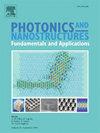非对称界面条波导中的Dyakonov表面波导模式
IF 2.9
3区 物理与天体物理
Q3 MATERIALS SCIENCE, MULTIDISCIPLINARY
Photonics and Nanostructures-Fundamentals and Applications
Pub Date : 2025-05-14
DOI:10.1016/j.photonics.2025.101397
引用次数: 0
摘要
我们报告了Dyakonov表面波导模式的理论预测,该模式沿着由两种各向异性材料形成的平坦带状界面波导传播,一侧由金属和另一侧由空气包围。我们证明了由于不对称的金属/空气边界条件,无论光学各向异性的类型如何,表面波都可以存在于这样的系统中。具有负各向异性的非对称波导支持强局域解,而在正各向异性的情况下,模强度随距离界面的距离缓慢衰减。在弱各向异性近似中,我们还用微扰理论分析了这些波的色散和场结构。我们证明,无论光学各向异性的类型如何,Dyakonov表面波导模式都表现出高度的圆偏振,在距离边界一定距离处达到±1的值。所得结果与有限元数值模拟结果一致。我们相信这项工作为Dyakonov表面波的实验研究及其实际应用开辟了新的机会。本文章由计算机程序翻译,如有差异,请以英文原文为准。
Dyakonov surface waveguide modes in asymmetric interfacial strip waveguide
We report a theoretical prediction of Dyakonov surface waveguide modes that propagate along a flat strip interfacial waveguide formed by two anisotropic materials, bounded by metal on one side and air on the other. We demonstrate that due to asymmetric metal/air boundary conditions, surface waves can exist in such a system regardless of the type of optical anisotropy. The asymmetric waveguide with negative anisotropy supports a strongly localized solution, whereas in the case of positive anisotropy, the mode intensity decays slowly with distance from the interface. We also analyze the dispersion and field structure of these waves using perturbation theory in the approximation of weak anisotropy. We demonstrate that, irrespective of the type of optical anisotropy, Dyakonov surface waveguide modes exhibit a high degree of circular polarization, reaching values of ±1 at certain distances from the boundaries. Our results are consistent with numerical simulations using the finite element method. We believe this work opens new opportunities for the experimental investigation of Dyakonov surface waves and their practical applications.
求助全文
通过发布文献求助,成功后即可免费获取论文全文。
去求助
来源期刊
CiteScore
5.00
自引率
3.70%
发文量
77
审稿时长
62 days
期刊介绍:
This journal establishes a dedicated channel for physicists, material scientists, chemists, engineers and computer scientists who are interested in photonics and nanostructures, and especially in research related to photonic crystals, photonic band gaps and metamaterials. The Journal sheds light on the latest developments in this growing field of science that will see the emergence of faster telecommunications and ultimately computers that use light instead of electrons to connect components.

 求助内容:
求助内容: 应助结果提醒方式:
应助结果提醒方式:


